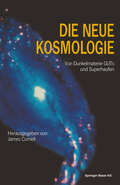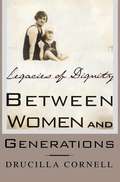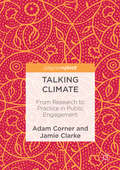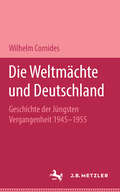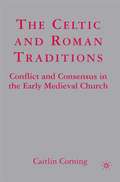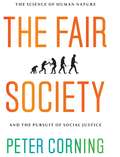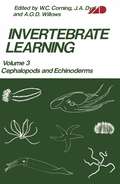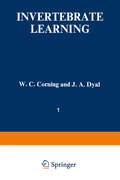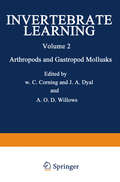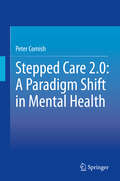- Table View
- List View
Between Women and Generations: Legacies of Dignity
by Drucilla CornellThis book defies easy categorization but will be one of the most original, thoughtful, and genuinely interesting books published next year. Before the author's mother died, she asked her daughter, Drucilla, to write a book 'that would bear witness to the dignity of her death [and one that] her bridge class would be able to understand.' As if that wasn't difficult enough, Drucilla's mother, who had a degenerative disease, decided to end her life by ingesting a lethal cocktail of drugs. Drucilla was in the unenviable position of bearing witness to her mother's act. Unsentimental yet poignant, candid and courageous, this is the book that Drucilla promised her mother she'd write. Unlike her earlier academically-oriented books, Between Women and Generations is an intensely personal narrative which interweaves the personal and political decisions Drucilla's made throughout her life. She uses the personal as a springboard to talk about larger philosophical issues such as how one achieves dignity in life and in death, and the nature of intergenerational relationships between women. Drucilla speaks candidly of her relationship with her mother, about her decision to adopt a non-Western child, and about her commitment to UNITY, a cooperative of house cleaners in Long Island, New York. This book will resonate strongly with Western women.
Wheat: Chemistry and Utilization
by Hugh Cornell Albert W. Hoveling"This book meets the need for a comprehensive, up-to-date review of wheat chemistry, processing and uses. It provides the reader with extensive new information on wheat components that will be useful in better commercial utilization of wheat and the formulation of new and upgraded wheat-based food products. The book serves as a one-volume information resource for all those involved in the research, development, formulation, and evaluation of wheat-based food products. From the Authors' PrefaceWheat continues to be one of the world's most important grains, especially as a food, where the unique properties of its products can be utilized to advantage. It provides an excellent example of a natural product from which a wide range of useful by-products can be made. This book discusses the components of the wheat kernel, which provide interesting examples of study of carbohydrate and protein chemistry, as well as lipids, minerals and vitamins. This book should serve as a useful reference for the cereal chemist, as well as chemists and food technologists in those industries in which by-products of flour are used, e.g., the confectionery industry in which modified starches and starch syrups are used. In addition, nutritionists, dieticians, and many kinds of researchers will find chapters of interest. Particular attention is given to particle-size determinations, an important area in food processing, and to the role of wheat proteins in gluten intolerance and wheat allergy. . . . Both the milling of wheat and flour quality are discussed in order to give the reader an idea of the distribution of the major components and the importance of proper size reduction. The book also has a chapter on wet milling of wheat flour . . . and chapters on the properties and uses of wheat starch, starch syrups, and chemically modified wheat starch.
Wheat: Chemistry and Utilization
by Hugh Cornell Albert W. Hoveling"This book meets the need for a comprehensive, up-to-date review of wheat chemistry, processing and uses. It provides the reader with extensive new information on wheat components that will be useful in better commercial utilization of wheat and the formulation of new and upgraded wheat-based food products. The book serves as a one-volume information resource for all those involved in the research, development, formulation, and evaluation of wheat-based food products. From the Authors' PrefaceWheat continues to be one of the world's most important grains, especially as a food, where the unique properties of its products can be utilized to advantage. It provides an excellent example of a natural product from which a wide range of useful by-products can be made. This book discusses the components of the wheat kernel, which provide interesting examples of study of carbohydrate and protein chemistry, as well as lipids, minerals and vitamins. This book should serve as a useful reference for the cereal chemist, as well as chemists and food technologists in those industries in which by-products of flour are used, e.g., the confectionery industry in which modified starches and starch syrups are used. In addition, nutritionists, dieticians, and many kinds of researchers will find chapters of interest. Particular attention is given to particle-size determinations, an important area in food processing, and to the role of wheat proteins in gluten intolerance and wheat allergy. . . . Both the milling of wheat and flour quality are discussed in order to give the reader an idea of the distribution of the major components and the importance of proper size reduction. The book also has a chapter on wet milling of wheat flour . . . and chapters on the properties and uses of wheat starch, starch syrups, and chemically modified wheat starch.
The Iron Oxides: Structure, Properties, Reactions, Occurrences and Uses
by Rochelle M. Cornell Udo SchwertmannThis book brings together in one, compact volume all aspects of the available information about the iron oxides. It presents a coherent, up to date account of the properties, reactions and mechanisms of formation of these compounds. In addition, there are chapters dealing with iron oxides in rocks and soils, as biominerals and as corrosion products together with methods of synthesis and the numerous application of these compounds. Their role in the environment is also discussed. The authors are experts in the field of iron oxides and have worked on all the topics covered. Much recent data from the authors' own laboratories is included and opportunities for further research are indicated. Special features are the electron micrographs and colour plates together with the many different spectra used to illustrate properties and aspects of behaviour. Numerous tables and graphs enable trends and relationships to be seen at a glance. The book concludes with an extensive bibliography. This book should prove invaluable to industry and to all researchers who, whatever their background and level of experience, are interested in this rapidly expanding field. It is an essential volume for any scientific library and is now in its second, completely revised and extended edition!
Talking Climate: From Research to Practice in Public Engagement
by Adam Corner Jamie ClarkeThis book describes a fresh approach to climate change communication: five core principles for public engagement that can propel climate change discourse out of the margins and into the mainstream. The question of how to communicate about climate change, and build public engagement in high-consuming, carbon-intensive Western nations, has occupied researchers, practitioners, and campaigners for more than two decades. During this time, limited progress has been made. Socially and culturally, climate change remains the preserve of a committed but narrow band of activists. Public engagement is stuck in second gear. By spanning the full width of the space between primary academic research and campaign strategies, this book will be relevant for academics, educators, campaigners, communicators and practitioners.
Hormones in Human Reproduction
by George Washington CornerA Scientific Book Club selection, this comprehensive account of the nature and function of the hormones in the processes of sex and reproduction.Originally published in 1942.The Princeton Legacy Library uses the latest print-on-demand technology to again make available previously out-of-print books from the distinguished backlist of Princeton University Press. These editions preserve the original texts of these important books while presenting them in durable paperback and hardcover editions. The goal of the Princeton Legacy Library is to vastly increase access to the rich scholarly heritage found in the thousands of books published by Princeton University Press since its founding in 1905.
Nanocosmetics: From Ideas to Products
by Jean Cornier Cornelia M. Keck Marcel Van de VoordeThis book addresses the application of nanotechnology to cosmetics. Edited by three respected experts in the field, the book begins with a general overview of the science behind cosmetics and skin care today, and of the status quo of nanotechnology in cosmetics. Subsequent chapters provide detailed information on the different nanoparticles currently used in cosmetics; the production and characterization of nanoparticles and nanocosmetics; and regulatory, safety and commercialization aspects. Given its scope, the book offers an indispensable guide for scientists in academia and industry, technicians and students, as well as a useful resource for decision-makers in the field and consumer organizations.Chapter 6 of this book is available open access under a CC BY 4.0 licence at link.springer.com.
Aqueous-Phase Organometallic Catalysis: Concepts and Applications
by Boy Cornils Wolfgang A. HerrmannNow in its second completely revised and expanded edition. Written by the renowned editors B. Cornils and W. A. Herrmann, this book presents every important aspect of aqueous-phase organometallic catalysis, a method which saves time, waste and money. The large-scale application of this "green" technology in chemical industry clearly underlines its practical use outside of academia. New chapters (for example "Organic Chemistry in Water"), 20% more content and fully updated contributions from a plethora of international authors make this book a "must-have" for everyone working in this field. From the reviews of the first edition: "This overview will be extremely useful for everyone active in this field [...]" Angewandte Chemie "This book is an essential in any chemical research library and I strongly recommend it to all synthetic research and teaching chemists. [...]" The Alchemist "The editors are to be congratulated on assembling such a wide range of contributors who have described the industrial as well as the academic aspects of the subject." [...] Journal of Organometallic Chemistry
Applied Homogeneous Catalysis with Organometallic Compounds: A Comprehensive Handbook in Four Volumes
by Boy Cornils Wolfgang A. Herrmann Matthias Beller Rocco PacielloThe completely revised third edition of this four-volume classic is fully updated and now includes such topics as as CH-activation and multicomponent reactions. It describes the most important reaction types, new methods and recent developments in catalysis. The internationally renowned editors and a plethora of international authors (including Nobel laureate R. Noyori) guarantee high quality content throughout the book. A "must read" for everyone in academia and industry working in this field.
Applied Homogeneous Catalysis with Organometallic Compounds: A Comprehensive Handbook in Four Volumes
by Boy Cornils Wolfgang A. Herrmann Matthias Beller Rocco PacielloThe completely revised third edition of this four-volume classic is fully updated and now includes such topics as as CH-activation and multicomponent reactions. It describes the most important reaction types, new methods and recent developments in catalysis. The internationally renowned editors and a plethora of international authors (including Nobel laureate R. Noyori) guarantee high quality content throughout the book. A "must read" for everyone in academia and industry working in this field.
The Celtic and Roman Traditions: Conflict and Consensus in the Early Medieval Church
by C. CorningThis book is a survey of the relationship between the two Celtic and Roman traditions in Merovingian Gaul, Lombard Italy, and the British Isles during the period of the Easter controversy. It looks at baptismal liturgy, the style of tonsure, and the correct dating of Easter.
Lehrbuch der Entwicklungsgeschichte des Menschen
by H. K. CorningDieser Buchtitel ist Teil des Digitalisierungsprojekts Springer Book Archives mit Publikationen, die seit den Anfängen des Verlags von 1842 erschienen sind. Der Verlag stellt mit diesem Archiv Quellen für die historische wie auch die disziplingeschichtliche Forschung zur Verfügung, die jeweils im historischen Kontext betrachtet werden müssen. Dieser Titel erschien in der Zeit vor 1945 und wird daher in seiner zeittypischen politisch-ideologischen Ausrichtung vom Verlag nicht beworben.
Lehrbuch der Entwicklungsgeschichte des Menschen
by Hanson Kelly CorningDieser Buchtitel ist Teil des Digitalisierungsprojekts Springer Book Archives mit Publikationen, die seit den Anfängen des Verlags von 1842 erschienen sind. Der Verlag stellt mit diesem Archiv Quellen für die historische wie auch die disziplingeschichtliche Forschung zur Verfügung, die jeweils im historischen Kontext betrachtet werden müssen. Dieser Titel erschien in der Zeit vor 1945 und wird daher in seiner zeittypischen politisch-ideologischen Ausrichtung vom Verlag nicht beworben.
The Fair Society: The Science of Human Nature and the Pursuit of Social Justice
by Peter CorningWe’ve been told, again and again, that life is unfair. But what if we’re wrong simply to resign ourselves to this situation? What if we have the power—and more, the duty—to change society for the better? We do. And our very nature inclines us to do so. That’s the provocative argument Peter Corning makes in The Fair Society. Drawing on the evidence from our evolutionary history and the emergent science of human nature, Corning shows that we have an innate sense of fairness. While these impulses can easily be subverted by greed and demagoguery, they can also be harnessed for good. Corning brings together the latest findings from the behavioral and biological sciences to help us understand how to move beyond the Madoffs and Enrons in our midst in order to lay the foundation for a new social contract—a Biosocial Contract built on a deep understanding of human nature and a commitment to fairness. He then proposes a sweeping set of economic and political reforms based on three principles of fairness—equality, equity, and reciprocity—that together could transform our society and our world. At this crisis point for capitalism, Corning reveals that the proper response to bank bailouts and financial chicanery isn’t to get mad—it’s to get fair.
The Fair Society: The Science of Human Nature and the Pursuit of Social Justice
by Peter CorningWe’ve been told, again and again, that life is unfair. But what if we’re wrong simply to resign ourselves to this situation? What if we have the power—and more, the duty—to change society for the better? We do. And our very nature inclines us to do so. That’s the provocative argument Peter Corning makes in The Fair Society. Drawing on the evidence from our evolutionary history and the emergent science of human nature, Corning shows that we have an innate sense of fairness. While these impulses can easily be subverted by greed and demagoguery, they can also be harnessed for good. Corning brings together the latest findings from the behavioral and biological sciences to help us understand how to move beyond the Madoffs and Enrons in our midst in order to lay the foundation for a new social contract—a Biosocial Contract built on a deep understanding of human nature and a commitment to fairness. He then proposes a sweeping set of economic and political reforms based on three principles of fairness—equality, equity, and reciprocity—that together could transform our society and our world. At this crisis point for capitalism, Corning reveals that the proper response to bank bailouts and financial chicanery isn’t to get mad—it’s to get fair.
The Fair Society: The Science of Human Nature and the Pursuit of Social Justice
by Peter CorningWe’ve been told, again and again, that life is unfair. But what if we’re wrong simply to resign ourselves to this situation? What if we have the power—and more, the duty—to change society for the better? We do. And our very nature inclines us to do so. That’s the provocative argument Peter Corning makes in The Fair Society. Drawing on the evidence from our evolutionary history and the emergent science of human nature, Corning shows that we have an innate sense of fairness. While these impulses can easily be subverted by greed and demagoguery, they can also be harnessed for good. Corning brings together the latest findings from the behavioral and biological sciences to help us understand how to move beyond the Madoffs and Enrons in our midst in order to lay the foundation for a new social contract—a Biosocial Contract built on a deep understanding of human nature and a commitment to fairness. He then proposes a sweeping set of economic and political reforms based on three principles of fairness—equality, equity, and reciprocity—that together could transform our society and our world. At this crisis point for capitalism, Corning reveals that the proper response to bank bailouts and financial chicanery isn’t to get mad—it’s to get fair.
Holistic Darwinism: Synergy, Cybernetics, and the Bioeconomics of Evolution
by Peter CorningIn recent years, evolutionary theorists have come to recognize that the reductionist, individualist, gene-centered approach to evolution cannot sufficiently account for the emergence of complex biological systems over time. Peter A. Corning has been at the forefront of a new generation of complexity theorists who have been working to reshape the foundations of evolutionary theory. Well known for his Synergism Hypothesis—a theory of complexity in evolution that assigns a key causal role to various forms of functional synergy—Corning puts this theory into a much broader framework in Holistic Darwinism, addressing many of the issues and concepts associated with the evolution of complex systems. Corning's paradigm embraces and integrates many related theoretical developments of recent years, from multilevel selection theory to niche construction theory, gene-culture coevolution theory, and theories of self-organization. Offering new approaches to thermodynamics, information theory, and economic analysis, Corning suggests how all of these domains can be brought firmly within what he characterizes as a post–neo-Darwinian evolutionary synthesis.
Holistic Darwinism: Synergy, Cybernetics, and the Bioeconomics of Evolution
by Peter CorningIn recent years, evolutionary theorists have come to recognize that the reductionist, individualist, gene-centered approach to evolution cannot sufficiently account for the emergence of complex biological systems over time. Peter A. Corning has been at the forefront of a new generation of complexity theorists who have been working to reshape the foundations of evolutionary theory. Well known for his Synergism Hypothesis—a theory of complexity in evolution that assigns a key causal role to various forms of functional synergy—Corning puts this theory into a much broader framework in Holistic Darwinism, addressing many of the issues and concepts associated with the evolution of complex systems. Corning's paradigm embraces and integrates many related theoretical developments of recent years, from multilevel selection theory to niche construction theory, gene-culture coevolution theory, and theories of self-organization. Offering new approaches to thermodynamics, information theory, and economic analysis, Corning suggests how all of these domains can be brought firmly within what he characterizes as a post–neo-Darwinian evolutionary synthesis.
Holistic Darwinism: Synergy, Cybernetics, and the Bioeconomics of Evolution
by Peter CorningIn recent years, evolutionary theorists have come to recognize that the reductionist, individualist, gene-centered approach to evolution cannot sufficiently account for the emergence of complex biological systems over time. Peter A. Corning has been at the forefront of a new generation of complexity theorists who have been working to reshape the foundations of evolutionary theory. Well known for his Synergism Hypothesis—a theory of complexity in evolution that assigns a key causal role to various forms of functional synergy—Corning puts this theory into a much broader framework in Holistic Darwinism, addressing many of the issues and concepts associated with the evolution of complex systems. Corning's paradigm embraces and integrates many related theoretical developments of recent years, from multilevel selection theory to niche construction theory, gene-culture coevolution theory, and theories of self-organization. Offering new approaches to thermodynamics, information theory, and economic analysis, Corning suggests how all of these domains can be brought firmly within what he characterizes as a post–neo-Darwinian evolutionary synthesis.
Invertebrate Learning: Volume 3 Cephalopods and Echinoderms
by W. C. Corning J. A. Dyal A. O. WillowsInvertebrate Learning: Volume 1 Protozoans Through Annelids
by William CorningSince the publication of the second volume of Comparative Psychology by Warden, Warner, and Jenkins (1940), there has not been a comprehensive review of invertebrate learning capacities. Some high-quality reviews have appeared in various journals, texts, and symposia, but they have been, of necessity, incomplete and selective either in terms of the phyla covered or the phenomena which were reviewed. Although this lack has served as a stimulus for the present series, the primary justification is to be found in the resurgence of theoretical and empirical interests in learning capacities and mechanisms in simpler systems of widely different phylogenetic origin. Intensive research on the physiological basis of learning and memory clearly entails exploration of the correlations between levels of nervous system organization and be havioral plasticity. Furthermore, the presence of structural-functional differ entiation in ganglionated systems, the existence of giant, easily identifiable cells, and the reduced complexity of structure and behavior repertoires are among the advantages of the "simple systems" strategy which have caused many neuroscientists to abandon their cats, rats, and monkeys in favor of mollusks, leeches, planaria, crayfish, protozoa, and other invertebrate preparations. Behavioral research continues to reveal remarkable capacities in these simple organisms and encourages us to believe that the confluence of the invertebrate learning data with the more voluminous vertebrate litera ture will contribute substantially to the enrichment of all of the neurobe havioral sciences.
Stepped Care 2.0: A Paradigm Shift in Mental Health
by Peter CornishThis book is a primer on Stepped Care 2.0. It is the first book in a series of three. This primer addresses the increased demand for mental health care by supporting stakeholders (help-seekers, providers, and policy-makers) to collaborate in enhancing care outcomes through work that is both more meaningful and sustainable. Our current mental health system is organized to offer highly intensive psychiatric and psychological care. While undoubtedly effective, demand far exceeds the supply for such specialized programming. Many people seeking to improve their mental health do not need psychiatric medication or sophisticated psychotherapy. A typical help seeker needs basic support. For knee pain, a nurse or physician might first recommend icing and resting the knee, working to achieve a healthy weight, and introducing low impact exercise before considering specialist care. Unfortunately, there is no parallel continuum of care for mental health and wellness. As a result, a person seeking the most basic support must line up and wait for the specialist along with those who may have very severe and/or complex needs. Why are there no lower intensity options? One reason is fear and stigma. A thorough assessment by a specialist is considered best practice. After all, what if we miss signs of suicide or potential harm to others? A reasonable question on the surface; however, the premise is flawed. First, the risk of suicide, or threat to others, for those already seeking care, is low. Second, our technical capacity to predict on these threats is virtually nil. Finally, assessment in our current culture of fear tends to focus more on the identification of deficits (as opposed to functional capacities), leading to over-prescription of expensive remedies and lost opportunities for autonomy and self-management. Despite little evidence linking assessment to treatment outcomes, and no evidence supporting our capacity to detect risk for harm, we persist with lengthy intake assessments and automatic specialist referrals that delay care. Before providers and policy makers can feel comfortable letting go of risk assessment, however, they need to understand the forces underlying the risk paradigm that dominates our society and restricts creative solutions for supporting those in need.
